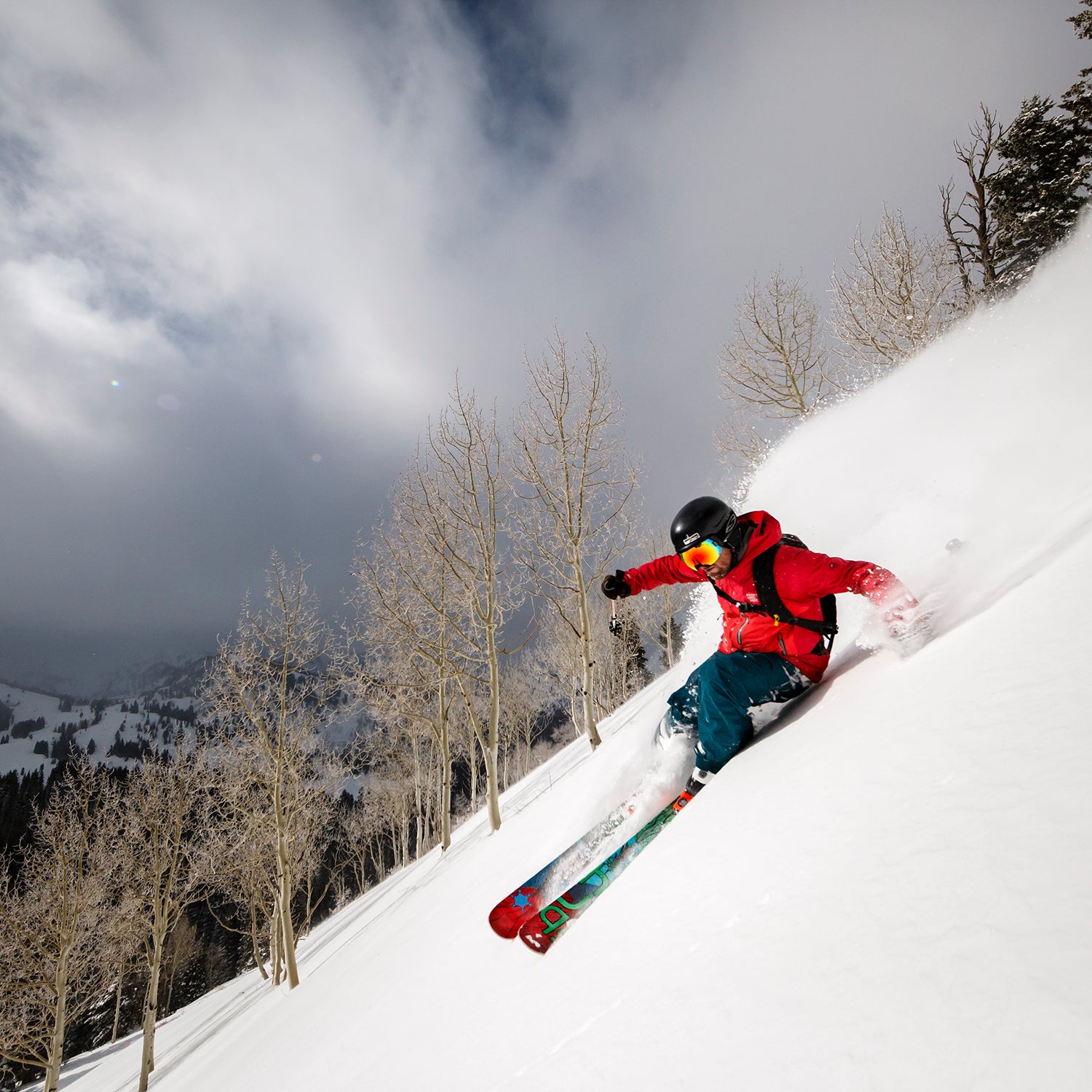At Party Beach Ski Camps, head coaches Lyndsay Strange and Marcus Caston believe that skiing should be fun. Strange, an Olympic ski coach, and Caston, a professional skier, teach the fundamentals to everyone from junior FIS racers to recreational adults during weeklong sessions at Oregon’s Mount Hood. They operate on the assumption that you won’t work hard to improve if you don’t enjoy what you’re doing, so they try to foster a genuine love of the sport. Unlike more traditional race camps, the two mix big-mountain techniques, freeskiing, and hitting jumps into their campers’ days on the snow.
Even if you’re more powder hound than ski racer, a little expert help can identify bad habits and make you a safer, more solid skier. Since in-person coaching is harder to come by these days, we asked Strange and Caston to lay out the core principles of good skiing for you to practice as soon as you hit the slopes.
Train for Balance
When you’re moving through variable terrain, you’re constantly reacting: you’re adjusting your turn shapes and absorbing changes in snow conditions, all while staying upright and moving downhill. The best skiers are light on their feet, making even tricky terrain look easy, because unexpected forces and impacts don’t throw them off balance.
Strange’s favorite balance drill is to practice skiing on one foot at a time. The easiest version of this is to simply practice standing still on one ski for about 30 seconds and then switching legs. Try it in the lift line if you’re feeling bold. If that’s too easy, find a wide groomer and see how well you can pick up your inside ski as you turn, keeping your weight on your outside ski. Focus on keeping your hips level with each other and both your hips and shoulders facing downhill. If you want to challenge yourself more, ditch your poles while you make those turns, or try the drill with your boots unbuckled.
Move to the Beat
Making a confident, well-balanced turn is step one. Linking that turn with another, and another, is where you really start to grow as a skier. Consistent, clean turns should feel rhythmic, like you’re skiing in time with a metronome.
To work on establishing and maintaining that rhythm, Caston has his campers focus on pole planting. As you near the end of, say, a left-hand turn, reach forward with your right hand and plant the tip of your pole firmly downslope. This marks the midpoint of your next turn. You’ll ski around that point and, toward the end of that right-hand turn, reach out and plant with your left. Keep your elbows gently bent and your hands out in front of you at about waist height. Rather than thinking about what your skis are doing immediately under your body, you should always be thinking—and looking—at least a half turn ahead. Confident pole plants help you do that.
Find a wide groomer and practice switching up your turn size: make five short radius turns followed by five big wide ones, emphasizing your pole plants, and keep alternating. Count them off in your head, doing your best to hold a consistent rhythm. If you lose it, stop and start over. If that feels too easy, try it in variable conditions or through bumps.
Ski with Your Edges
If the flat bases of your skis are always flush to the ground, you’re sliding, not skiing. As your skis flex through the farthest point of a turn, most of your weight should be on the inside edge of your outside ski, the sharpened metal biting into the snow and drawing a neat arc. As you transition into the next turn, quickly shift that weight to the inside edge of the opposite ski. Good edge engagement is critical to skiing fast, navigating dicey conditions, and maintaining control.
To get their campers to think through every part of a turn, Strange and Caston use a drill called controlled edge sets, which look a little like connected hockey stops. To start, stand on the hill perpendicular to the slope, with your uphill edges dug in. While keeping your skis as parallel as possible, pole-plant, roll your ankles into a turn around your pole, and set up again in the opposite direction, engaging your edges to fully stop your momentum. Stopping short forces you to use your edges instead of your momentum to turn, and it trains balance and speed control. “It gets you grounded,” Caston says. “You really have to feel what your knees and ankles are doing.”
Lean into It
A proper ski stance is aggressive: knees and hips bent, with your weight forward over the tips of your skis. Maybe you’ve heard someone use the phrase “skiing in the back seat” to describe bad form—that is, skiing with straightened legs and an upright stance, leaning back on your heels, and trying to make turns by pivoting from the back half of your skis. You want to be in the driver’s seat, with your shins pressed firmly against the front of your boots, your weight in the balls of your feet, and your hands forward. This will help you initiate smooth, stable turns with your entire edge. It also keeps your body and skis facing into the fall line—the most direct downhill path—which makes for controlled, efficient skiing.
Once you’ve got your stance down, give the “TV screen” drill a go on a mellow groomer: Flip your poles up, with the tips in the air so they’re framing an image downhill. Your hands should be about level with your waist. Make short radius turns, maintaining that same view between your poles. Keeping your hands and eyes forward should help shift your body positioning forward as you move downhill.
Work Your Sides in the Steeps
Even if you’ve mastered fall-line skiing elsewhere, when you get into steep terrain, your instinct might still be to move sideways, swinging your whole body around with each turn and finishing with your skis perpendicular to the slope. To maintain that aggressive fall-line stance through steep turns, you need to pivot at the waist, moving your lower body into a turn while keeping your upper body facing downhill.
Our bodies don’t often move this way off of the snow, so Caston and Strange have their campers practice a drill they call “pinching the doughnut.” To do it, you create a sideways-facing C between your inside hip and shoulder by engaging your obliques, bringing your lower ribs toward your hip bones and rotating from the waist each time you initiate a downhill turn. Exaggerate the movement. The steeper the slope, the more aggressive that C-angle should be.
Get By with a Little Help from Your Friends
Skiing is an individual sport, but Caston explains that it’s often easier to work on technique in a group. You can talk with one or two friends about what you’re trying to practice and rely on a second set of eyes to let you know when you’re finally getting it down. “Surround yourself with good people who are working on things, too,” Strange says. “Be the coach, and let your friend coach you.”
Caston recommends starting your mornings with a few drills and then transitioning to what he calls focused freeskiing. Pick just one goal—like holding a rhythm—to keep in mind all day. It’s easy to get overwhelmed by too many moving parts, so be patient and give your body the time it needs to absorb a skill before turning to the next one.
There are some cold, hard truths about ski technique, but at the end of the day, it’s a creative sport, and what makes it interesting is how you interpret the basics. Caston and Strange’s most reliable piece of advice? Have a good time. As Strange says, the better you are at skiing, the more fun it is—and the more fun you’re having, the better you’ll get.


